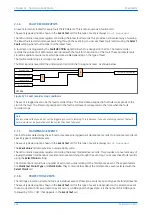
may be slower than would normally be expected. The Total Current Accumulator (I^ counter) cumulatively stores
the total value of the current broken by the circuit breaker providing a more accurate assessment of the circuit
breaker condition.
The dielectric withstand of the oil generally decreases as a function of I
2
t, where ‘I’ is the broken fault current and
‘t’ is the arcing time within the interrupter tank. The arcing time cannot be determined accurately, but is generally
dependent on the type of circuit breaker being used. Instead, you set a factor (Broken I^) with a value between 1
and 2, depending on the circuit breaker.
Most circuit breakers would have this value set to '2', but for some types of circuit breaker, especially those
operating on higher voltage systems, a value of 2 may be too high. In such applications Broken I^ may be set
lower, typically 1.4 or 1.5.
The setting range for Broken I^ is variable between 1.0 and 2.0 in 0.1 steps.
Note:
Any maintenance program must be fully compliant with the switchgear manufacturer’s instructions.
5.8.2
SETTING THE THRESHOLDS FOR THE NUMBER OF OPERATIONS
Every circuit breaker operation results in some degree of wear for its components. Therefore routine maintenance,
such as oiling of mechanisms, may be based on the number of operations. Suitable setting of the maintenance
threshold will allow an alarm to be raised, indicating when preventative maintenance is due. Should maintenance
not be carried out, the device can be set to lockout the autoreclose function on reaching a second operations
threshold (No. CB ops Lock). This prevents further reclosure when the circuit breaker has not been maintained to
the standard demanded by the switchgear manufacturer’s maintenance instructions.
Some circuit breakers, such as oil circuit breakers (OCBs) can only perform a certain number of fault interruptions
before requiring maintenance attention. This is because each fault interruption causes carbonising of the oil,
degrading its dielectric properties. The maintenance alarm threshold (setting No. CB Ops Maint) may be set to
indicate the requirement for oil dielectric testing, or for more comprehensive maintenance. Again, the lockout
threshold No. CB Ops Lock may be set to disable autoreclosure when repeated further fault interruptions could
not be guaranteed. This minimises the risk of oil fires or explosion.
5.8.3
SETTING THE THRESHOLDS FOR THE OPERATING TIME
Slow CB operation indicates the need for mechanism maintenance. Alarm and lockout thresholds (CB Time Maint
and CB Time Lockout) are provided to enforce this. They can be set in the range of 5 to 500 ms. This time relates to
the interrupting time of the circuit breaker.
5.8.4
SETTING THE THRESHOLDS FOR EXCESSSIVE FAULT FREQUENCY
Persistent faults will generally cause autoreclose lockout, with subsequent maintenance attention. Intermittent
faults such as clashing vegetation may repeat outside of any reclaim time, and the common cause might never be
investigated. For this reason it is possible to set a frequent operations counter, which allows the number of
operations Fault Freq Count over a set time period Fault Freq Time to be monitored. A separate alarm and lockout
threshold can be set.
Chapter 12 - Monitoring and Control
P54A/B/C/E
258
P54xMED-TM-EN-1
Summary of Contents for P4A
Page 2: ......
Page 20: ...Contents P54A B C E xviii P54xMED TM EN 1 ...
Page 27: ...CHAPTER 1 INTRODUCTION ...
Page 28: ...Chapter 1 Introduction P54A B C E 2 P54xMED TM EN 1 ...
Page 38: ...Chapter 1 Introduction P54A B C E 12 P54xMED TM EN 1 ...
Page 39: ...CHAPTER 2 SAFETY INFORMATION ...
Page 40: ...Chapter 2 Safety Information P54A B C E 14 P54xMED TM EN 1 ...
Page 52: ...Chapter 2 Safety Information P54A B C E 26 P54xMED TM EN 1 ...
Page 53: ...CHAPTER 3 HARDWARE DESIGN ...
Page 54: ...Chapter 3 Hardware Design P54A B C E 28 P54xMED TM EN 1 ...
Page 86: ...Chapter 3 Hardware Design P54A B C E 60 P54xMED TM EN 1 ...
Page 87: ...CHAPTER 4 SOFTWARE DESIGN ...
Page 88: ...Chapter 4 Software Design P54A B C E 62 P54xMED TM EN 1 ...
Page 99: ...CHAPTER 5 CONFIGURATION ...
Page 100: ...Chapter 5 Configuration P54A B C E 74 P54xMED TM EN 1 ...
Page 120: ...Chapter 5 Configuration P54A B C E 94 P54xMED TM EN 1 ...
Page 121: ...CHAPTER 6 CURRENT DIFFERENTIAL PROTECTION ...
Page 122: ...Chapter 6 Current Differential Protection P54A B C E 96 P54xMED TM EN 1 ...
Page 149: ...CHAPTER 7 AUTORECLOSE ...
Page 150: ...Chapter 7 Autoreclose P54A B C E 124 P54xMED TM EN 1 ...
Page 207: ...CHAPTER 8 CB FAIL PROTECTION ...
Page 208: ...Chapter 8 CB Fail Protection P54A B C E 182 P54xMED TM EN 1 ...
Page 219: ...CHAPTER 9 CURRENT PROTECTION FUNCTIONS ...
Page 220: ...Chapter 9 Current Protection Functions P54A B C E 194 P54xMED TM EN 1 ...
Page 244: ...Chapter 9 Current Protection Functions P54A B C E 218 P54xMED TM EN 1 ...
Page 247: ...CHAPTER 10 VOLTAGE PROTECTION FUNCTIONS ...
Page 248: ...Chapter 10 Voltage Protection Functions P54A B C E 222 P54xMED TM EN 1 ...
Page 261: ...CHAPTER 11 FREQUENCY PROTECTION FUNCTIONS ...
Page 262: ...Chapter 11 Frequency Protection Functions P54A B C E 236 P54xMED TM EN 1 ...
Page 268: ...Chapter 11 Frequency Protection Functions P54A B C E 242 P54xMED TM EN 1 ...
Page 269: ...CHAPTER 12 MONITORING AND CONTROL ...
Page 270: ...Chapter 12 Monitoring and Control P54A B C E 244 P54xMED TM EN 1 ...
Page 300: ...Chapter 12 Monitoring and Control P54A B C E 274 P54xMED TM EN 1 ...
Page 301: ...CHAPTER 13 SUPERVISION ...
Page 302: ...Chapter 13 Supervision P54A B C E 276 P54xMED TM EN 1 ...
Page 312: ...Chapter 13 Supervision P54A B C E 286 P54xMED TM EN 1 ...
Page 323: ...CHAPTER 14 DIGITAL I O AND PSL CONFIGURATION ...
Page 324: ...Chapter 14 Digital I O and PSL Configuration P54A B C E 298 P54xMED TM EN 1 ...
Page 336: ...Chapter 14 Digital I O and PSL Configuration P54A B C E 310 P54xMED TM EN 1 ...
Page 337: ...CHAPTER 15 FIBRE TELEPROTECTION ...
Page 338: ...Chapter 15 Fibre Teleprotection P54A B C E 312 P54xMED TM EN 1 ...
Page 354: ...Chapter 15 Fibre Teleprotection P54A B C E 328 P54xMED TM EN 1 ...
Page 355: ...CHAPTER 16 ELECTRICAL TELEPROTECTION ...
Page 356: ...Chapter 16 Electrical Teleprotection P54A B C E 330 P54xMED TM EN 1 ...
Page 366: ...Chapter 16 Electrical Teleprotection P54A B C E 340 P54xMED TM EN 1 ...
Page 367: ...CHAPTER 17 COMMUNICATIONS ...
Page 368: ...Chapter 17 Communications P54A B C E 342 P54xMED TM EN 1 ...
Page 439: ...CHAPTER 18 CYBER SECURITY ...
Page 440: ...Chapter 18 Cyber Security P54A B C E 414 P54xMED TM EN 1 ...
Page 457: ...CHAPTER 19 INSTALLATION ...
Page 458: ...Chapter 19 Installation P54A B C E 432 P54xMED TM EN 1 ...
Page 471: ...CHAPTER 20 COMMISSIONING INSTRUCTIONS ...
Page 472: ...Chapter 20 Commissioning Instructions P54A B C E 446 P54xMED TM EN 1 ...
Page 513: ...CHAPTER 21 MAINTENANCE AND TROUBLESHOOTING ...
Page 514: ...Chapter 21 Maintenance and Troubleshooting P54A B C E 488 P54xMED TM EN 1 ...
Page 530: ...Chapter 21 Maintenance and Troubleshooting P54A B C E 504 P54xMED TM EN 1 ...
Page 531: ...CHAPTER 22 TECHNICAL SPECIFICATIONS ...
Page 532: ...Chapter 22 Technical Specifications P54A B C E 506 P54xMED TM EN 1 ...
Page 558: ...Chapter 22 Technical Specifications P54A B C E 532 P54xMED TM EN 1 ...
Page 559: ...APPENDIX A ORDERING OPTIONS ...
Page 560: ...Appendix A Ordering Options P54A B C E P54xMED TM EN 1 ...
Page 565: ...APPENDIX B SETTINGS AND SIGNALS ...
Page 566: ...Appendix B Settings and Signals P54A B C E P54xMED TM EN 1 ...
Page 790: ...Appendix B Settings and Signals P54A B C E B224 P54xMED TM EN 1 ...
Page 835: ...APPENDIX C WIRING DIAGRAMS ...
Page 836: ...Appendix C Wiring Diagrams P54A B C E P54xMED TM EN 1 ...
Page 849: ......
















































